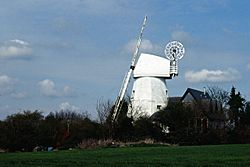Gibraltar Mill, Great Bardfield facts for kids
Quick facts for kids Great Bardfield Mill |
|
|---|---|

The mill in April 2006
|
|
| Origin | |
| Mill name | Gibraltar Mill |
| Mill location | TL 68004 30727 |
| Coordinates | 51°56′59″N 0°26′35″E / 51.94966°N 0.44319°E |
| Operator(s) | Private |
| Year built | c1704 |
| Information | |
| Purpose | Corn mill |
| Type | Tower mill |
| Storeys | Three storeys |
| No. of sails | Four sails |
| Type of sails | Double Patent sails |
| Windshaft | Cast iron |
| Winding | Fantail |
| Fantail blades | Eight blades |
| No. of pairs of millstones | Two pairs |
Gibraltar Mill is a fascinating old windmill located in Great Bardfield, Essex, England. It's a special type of windmill called a tower mill, which means it has a tall, round stone or brick tower. Today, this historic building is no longer grinding grain; it has been turned into a home! It is recognized as a Grade II listed building, meaning it's an important historical site.
Contents
The Mill's Long History
This windmill has stood for a very long time. We know for sure there was a mill here by 1707. Some people think it might have been built as early as 1680. However, old maps from 1678 don't show a mill here.
Building the Mill
The most likely year Gibraltar Mill was built is 1704. It's possible an older mill was destroyed in the terrible Great Storm of 1703. This new mill would have been built to replace it.
Changes Over Time
By 1754, the mill had stopped working as a mill. It was turned into a small house or cottage. But by 1806, it was back in action as a working windmill! Its value had gone up a lot, from £50 in 1800 to £300.
Sometimes, Gibraltar Mill worked together with the nearby Great Bardfield Watermill. In 1877, the mill got a new part called a windshaft, which is a big axle that holds the sails. The old wooden one was replaced with a strong cast iron one.
Storms and Repairs
Windmills are powerful, but they can be damaged by strong winds. In January 1899, a big storm hit Gibraltar Mill. The sails were blown off, and the top part, called the cap, was badly damaged. The mill stood without its cap for five years.
In 1904, it finally got a new cap and sails. A new part called a fantail was also added. This fantail automatically turned the cap and sails into the wind. Before this, workers had to turn it by hand.
End of an Era
The mill kept working until 1930. In 1938, there was a plan to tear it down. But the Essex County Council stepped in and used a special law to save it. After the last miller passed away in the late 1950s, the mill's machinery was removed. It was then fully converted into a house.
Even after it became a home, the mill faced another challenge. One of its sails was damaged during the Great Storm of 1987, a very powerful storm that hit England.
How the Mill Was Built
Gibraltar Mill is a three-storey tower mill. This means it has three main levels inside its tall, round tower. The very top of the mill has a special boat-shaped cap.
Key Parts of the Mill
- Sails: The mill has four large sails. These are called "double Patent sails," which were a clever design that allowed millers to adjust them easily.
- Windshaft: The sails are attached to a strong cast iron windshaft, which is like a giant axle.
- Fantail: An eight-bladed fantail helps the mill automatically turn its cap and sails to face the wind. This makes sure the mill always catches the most wind.
The Tower's Size
The tower itself is very strong. At the bottom, its walls are about 3 to 4 feet (about 1 meter) thick! The entire tower stands about 32 feet (about 9.7 meters) high. At its base, it's about 20 feet (about 6 meters) wide, and it gets narrower towards the top, where it's about 13 feet (about 4 meters) wide. The total height of the mill, including the cap, is about 44 feet (about 13.4 meters).
Inside the Mill
Inside, the windshaft was connected to a large wooden Brake Wheel. This wheel had 90 iron teeth. The Brake Wheel turned another gear called the Wallower, which had 44 wooden cogs. These gears helped transfer the power from the wind to the grinding stones.
The Wallower was connected to an Upright Shaft. At the bottom of this shaft was the Great Spur Wheel, which had 88 cogs. This wheel then drove two pairs of millstones through smaller gears called Stone Nuts. Each Stone Nut had 18 cogs. These millstones were used to grind grain into flour.
Millers of Gibraltar Mill
Many people worked at Gibraltar Mill over the centuries, grinding grain for the local community. Here are some of the millers who operated Gibraltar Mill:
- Jonas Osbourne (1754)
- Thomas Joslin (1767 - 1792)
- John Joslin (1800 - 1803)
- John Brown (1803 - 1809)
- Thomas Marriage
- Henry Marriage (until 1855)
- Thomas Dixon Smith (1872 - 1878)
- Thomas Samuel Smith (1894–1930)

